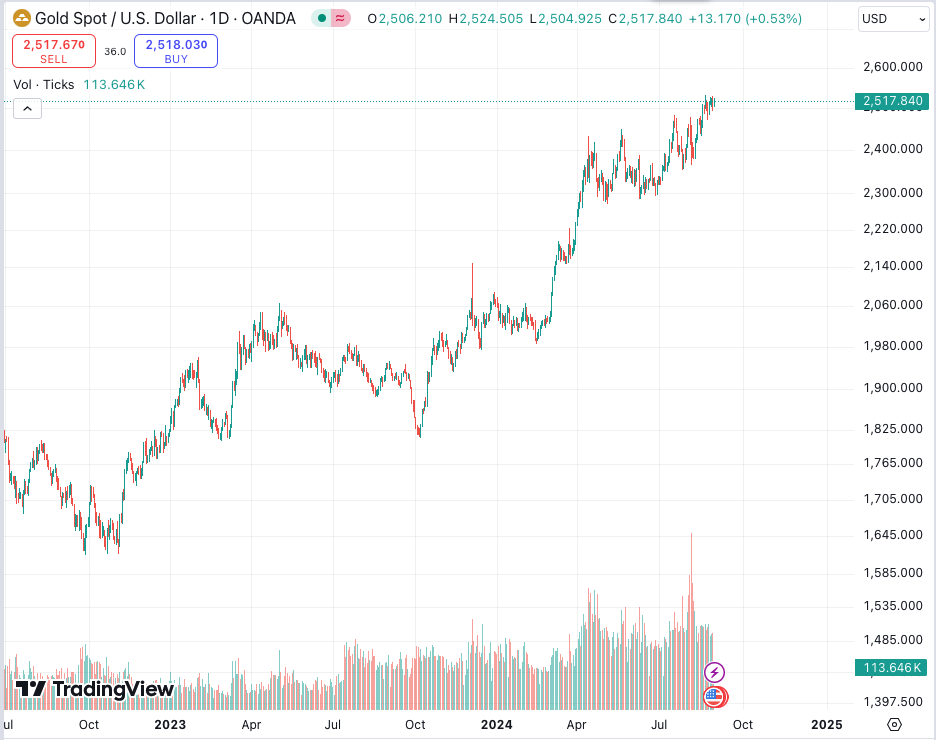Gold, often referred to as a “safe haven” asset, has seen a significant and steady increase in price over the last two years, from $1,620 per ounce in September 2022, to $2,520 today. This trend can be attributed to a combination of economic factors, geopolitical uncertainties, and market dynamics. Here’s an in-depth look at why gold prices have been on the rise and what it means for investors.

Economic Uncertainty and Safe Haven Demand
One of the primary drivers of the recent rise in gold prices is global economic uncertainty. In times of financial instability, investors tend to flock to gold as a safe haven. The COVID-19 pandemic has had a lasting impact on global economies, leading to disruptions in supply chains, shifts in consumer behavior, and ongoing fears of future economic slowdowns. Additionally, concerns over rising national debts and the sustainability of economic recovery have prompted many investors to seek refuge in gold.
Inflation as a Key Factor
Inflation fears have also played a significant role in the increasing price of gold. As governments around the world implemented expansive fiscal policies to combat the economic effects of the pandemic, inflation began to rise. Gold is traditionally viewed as a hedge against inflation; when the purchasing power of fiat currencies diminishes, gold tends to retain or even increase its value. This has made gold an attractive investment as a means of preserving wealth in an inflationary environment.
Central Bank Policies and Interest Rates
Central banks globally have kept interest rates at historically low levels to stimulate economic activity. Low interest rates reduce the opportunity cost of holding non-yielding assets like gold, making it more attractive. Furthermore, some central banks have been actively purchasing gold to diversify their reserves, adding additional upward pressure on prices.
Geopolitical Tensions
The geopolitical landscape has been fraught with tensions over the last couple of years, adding to the uncertainty in financial markets. The conflict between Russia and Ukraine, ongoing issues in the Middle East, and trade tensions between major economies like the U.S. and China have all contributed to an increased demand for gold. In times of geopolitical instability, gold is often seen as a stable asset that can preserve value when other assets might suffer from volatility.
Supply Constraints
While demand for gold has been rising, supply has not kept pace. The pandemic disrupted mining operations across the globe, leading to reduced output. Additionally, stricter environmental regulations in key gold-producing countries have further constrained supply. This mismatch between demand and supply has naturally led to higher prices.
Where Could Gold Prices Go from Here?
The upward trend in gold prices over the past two years has many investors wondering if the momentum will continue or if the market is due for a correction. Predicting the future price of gold is challenging, as it depends on a variety of factors, both macroeconomic and geopolitical. However, by analyzing the current landscape, we can make informed projections.
Continued Economic Uncertainty
The global economic environment remains volatile. Issues like inflation, potential recessions, and high national debt levels are likely to persist in the coming years. As long as these factors are present, the demand for gold as a safe haven is expected to remain strong. If economic uncertainty continues, gold prices could see further gains as investors seek stability.
Potential for Inflation to Rise Further
While inflation has been a significant driver of gold prices recently, it could still have a long way to go. Should inflation rates continue to rise, driven by ongoing supply chain disruptions, rising energy costs, or additional fiscal stimulus, gold will likely retain its appeal as a hedge. This scenario could push gold prices even higher, especially if central banks struggle to keep inflation under control.
Interest Rate Movements
Interest rates are a double-edged sword for gold. On one hand, low-interest rates reduce the opportunity cost of holding gold, making it more attractive. On the other hand, if central banks, particularly the Federal Reserve, decide to increase interest rates aggressively to combat inflation, it could negatively impact gold prices. Higher interest rates generally strengthen the currency and make non-yielding assets like gold less appealing. Investors should closely monitor central bank policies, as shifts in interest rates could be a key determinant of gold’s future trajectory.
Geopolitical Uncertainties
Geopolitical events are notoriously difficult to predict, yet they have a profound impact on gold prices. With ongoing tensions in various parts of the world, the likelihood of sudden, unexpected events remains high. Any major geopolitical crisis could drive a surge in gold prices, as investors flock to it as a safe-haven asset. Conversely, a period of relative geopolitical stability could slow the upward momentum.
Supply Dynamics
The supply of gold is another crucial factor. If mining production increases significantly or if new, substantial gold reserves are discovered, it could alleviate some of the upward pressure on prices. However, given the current environmental and regulatory challenges facing the mining industry, a significant increase in supply seems unlikely in the short term. Thus, supply constraints are likely to continue supporting high gold prices.
Is Now the Right Time to Invest in Gold?
Deciding whether to invest in gold now depends on your financial goals, risk tolerance, and outlook on the factors discussed above. If you believe that economic uncertainty, inflation, and geopolitical tensions will persist or worsen, then gold could be a valuable addition to your portfolio as a hedge against these risks.
However, it is also essential to consider that gold prices have already seen a substantial increase. Some market analysts argue that the current prices may have already factored in many of these concerns, potentially limiting the upside from here. As with any investment, timing and diversification are key.
Maintaining a balanced portfolio that includes gold could offer protection against volatility in other asset classes. For those who are cautious about entering the market at current levels, dollar-cost averaging—investing a fixed amount in gold at regular intervals—could be a strategy to mitigate the risk of a significant price correction.
Keep Informed
While no one can predict the future with certainty, the factors that have driven gold prices higher over the past two years are likely to continue influencing the market. If you’re considering investing in gold, it’s crucial to stay informed about economic indicators, central bank policies, and global geopolitical developments. By doing so, you can make more informed decisions and potentially capitalize on the ongoing trends in the gold market.
Looking to make more data-driven trading decisions? Arrow Algo offers tools and resources to help you optimize your investment strategies in the current market environment. Explore more on our blog. Trade Gold on Arrow Algo through the PAXG gold token.

Did you enjoy this? You may like:


Leave a Reply